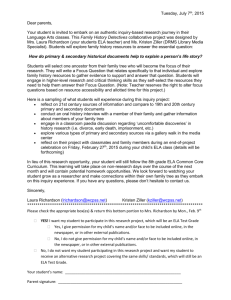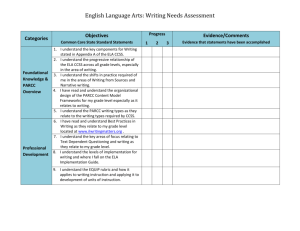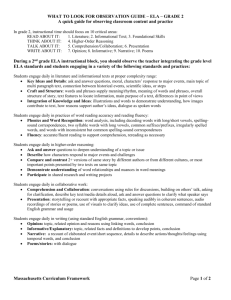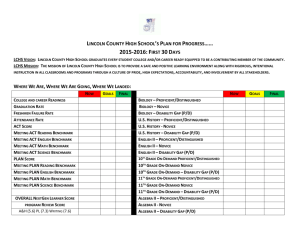Student Learning Target
advertisement
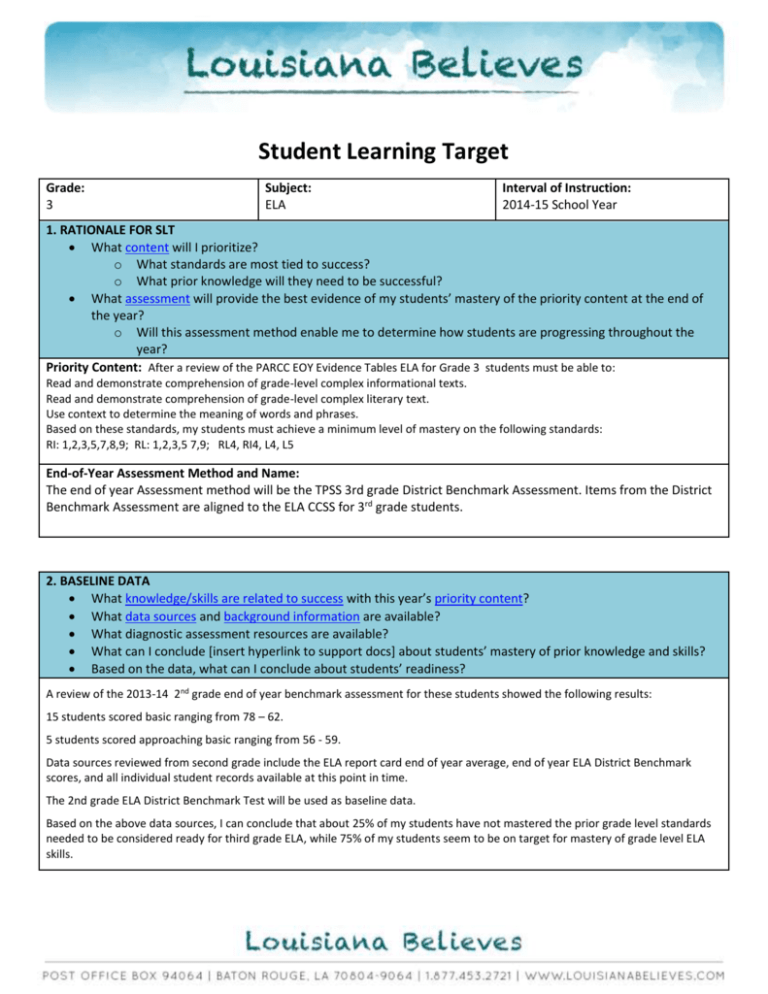
Student Learning Target Grade: 3 Subject: ELA Interval of Instruction: 2014-15 School Year 1. RATIONALE FOR SLT What content will I prioritize? o What standards are most tied to success? o What prior knowledge will they need to be successful? What assessment will provide the best evidence of my students’ mastery of the priority content at the end of the year? o Will this assessment method enable me to determine how students are progressing throughout the year? Priority Content: After a review of the PARCC EOY Evidence Tables ELA for Grade 3 students must be able to: Read and demonstrate comprehension of grade‐level complex informational texts. Read and demonstrate comprehension of grade‐level complex literary text. Use context to determine the meaning of words and phrases. Based on these standards, my students must achieve a minimum level of mastery on the following standards: RI: 1,2,3,5,7,8,9; RL: 1,2,3,5 7,9; RL4, RI4, L4, L5 End-of-Year Assessment Method and Name: The end of year Assessment method will be the TPSS 3rd grade District Benchmark Assessment. Items from the District Benchmark Assessment are aligned to the ELA CCSS for 3rd grade students. 2. BASELINE DATA What knowledge/skills are related to success with this year’s priority content? What data sources and background information are available? What diagnostic assessment resources are available? What can I conclude [insert hyperlink to support docs] about students’ mastery of prior knowledge and skills? Based on the data, what can I conclude about students’ readiness? A review of the 2013-14 2nd grade end of year benchmark assessment for these students showed the following results: 15 students scored basic ranging from 78 – 62. 5 students scored approaching basic ranging from 56 - 59. Data sources reviewed from second grade include the ELA report card end of year average, end of year ELA District Benchmark scores, and all individual student records available at this point in time. The 2nd grade ELA District Benchmark Test will be used as baseline data. Based on the above data sources, I can conclude that about 25% of my students have not mastered the prior grade level standards needed to be considered ready for third grade ELA, while 75% of my students seem to be on target for mastery of grade level ELA skills. 3. NUMBER OF STUDENTS Have I set learning targets for all of my students? Which subgroups in my school population need additional support to achieve success? Which students will need additional support to achieve success? All 3rd grade ELA students for this 2014-15 school year will be the focus of this learning target. Special needs, 504, and students with lowest benchmark scores will need additional support throughout the year. Using the midyear benchmark assessment for progress monitoring, these students will receive extra resources through System 44, and Storytown Tier II, III based on their specific deficit skills. Classroom common formative assessments will be used weekly for progress monitoring of all students. STUDENT LEARNING TARGET: What level of performance on the end-of-year assessment from Step 1 do I expect the identified student population to achieve? 56% of students will achieve basic or above on the 3rd grade End of Year ELA District Benchmark Assessment. SCORING PLAN: How will you measure your students’ success? Based on students’ baseline data, what is the minimum level of performance I expect from the identified students? Based on students’ baseline data, how many students can reasonably be expected to meet or exceed the expected level of performance? Insufficient Attainment of Target (1 point): The teacher has demonstrated an insufficient impact on student learning by falling far short of the target. Partial Attainment of Target (2 points): The teacher has demonstrated some impact on student learning, but did not meet the target. Full Attainment of Target (3 points): The teacher has demonstrated a considerable impact on student learning by meeting the target. Exceptional Attainment of Target (4 points): The teacher has demonstrated an outstanding impact on student learning by surpassing the target by a meaningful margin. Achievement range: < 39% or below of students will reach the established achievement level of basic or above. Achievement range: 40% - 55% of students will reach the established achievement level of basic or above. Achievement range: 56% -71% of students will reach the established achievement level of basic or above. Achievement range: >72% or above of students will reach the established achievement level of basic or above. 4. HOW WILL I MONITOR PROGRESS? When will I monitor students’ developing mastery of the priority content? What curricular resources and assessment methods will I use to determine students’ mastery of the priority content on an on-going basis? o Are these assessment methods aligned with the end-of-year assessment identified in Step 1? 4. HOW WILL I MONITOR PROGRESS? When will I monitor students’ developing mastery of the priority content? What curricular resources and assessment methods will I use to determine students’ mastery of the priority content on an on-going basis? o Are these assessment methods aligned with the end-of-year assessment identified in Step 1? Ongoing 3rd grade students will engage in ELA instruction that focuses on major content and daily fluency exercises. I will use StoryTown which is aligned to CCSS, LDOE Guidebook, Common Formative Assessments, SRI, and other appropriate ELA resources to monitor student mastery on an on-going basis. Practice test items including EAGLE will be used as bell ringers on a daily basis. District Benchmark tests aligned to PARCC will be administered at three checkpoints. Student test data will be reviewed and discussed at weekly collaboration meetings. Checkpoint 1 Teachers will assess students August 18 September 12 using the ELA 3rd grade District Benchmark Assessment Checkpoint 2 Teachers will assess students November 17 - December 19 using the ELA 3rd grade District Benchmark Assessment Checkpoint 3 Teachers will assess students February 9 – March 13 using the ELA 3rd grade District Benchmark Assessment

